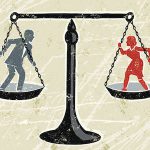Recycling as a concept is not a bad idea. It is in the execution where things go awry. A logical leap fallacy occurs when assuming that because the recycling of materials A-D makes sense it must mean also that the recycling of materials E-Z makes sense.
Generally speaking the recycling of metals and glass make economic sense because reuse involves less effort than production. Due to the chemical nature of plastics it is practically impossible to recycle them for their original application. And the whole notion of recycling paper to “save a tree” makes about as much sense as not eating tortillas in order to “save corn.” If paper weren’t being used, then tree farmers would not plant trees. Contrary to popular mythology paper does not come from old growth forests – it comes from tree farms. In fact an argument can be made that virgin paper is actually better for the environment than recycled paper. Trees remove carbon from the atmosphere. Recycling of paper just tosses that same carbon back and forth like pitcher to catcher; virgin paper use creates a steady withdrawal of carbon from the atmosphere.
How do we know when recycling is “good” vs just “feel good”? If money is offered or it’s something best not released into the environment are two key indicators. Sometimes those two things coincide as in the case of lead acid batteries. Recycling these batteries creates a “double-whammy” effect: you make money and protect the environment! Who could object to that? The EPA apparently. Read on.
Last year our company had to replace the lead-acid batteries in our corporate power back up system. We had to unload over a thousand pounds worth of them and I was not keen on just dumping them in the trash. Fortuitously enough I was able to locate a company not far from us in Watkinsville that would not only take them off our hands but also cut us a check for them. This provided an incentive for me to stockpile my own used lead-acid batteries at home. After about a year or so and a hundred pounds later I was ready to divest myself of these batteries. Unfortunately that local recycler was out of business. No problem I thought, there is a county recycling station not far on Highway 15. So I drove on over only to discover for some bizarre reason they are not open Tuesday or Thursday, and my luck being what it was, it was Thursday. Artificially constrained hours of operation accompanied by a gate for an open-air facility is truly puzzling. Are they afraid someone is going to steal the recyclables? Wouldn’t that be a good thing? Artificially constrained access encourages people to not even bother if they have to make a special trip vs simply taking care of it when most convenient.
However, it turns out the closure did not matter as they don’t accept lead-acid batteries. Ok, so does my curbside garbage service take them in their recycling? Nope. Ok, surely the county dump takes them! Everything ultimately ends up in the dump, right? It’s the trash bin of last resort. So I drove to the Oconee county dump only to be told, no, they can’t accept lead-acid batteries due to EPA restrictions. So, let me get this straight, the EPA, the organization charged with ensuring the environment is protected from harm has set up regulations that prohibit a DUMP from accepting a known environmentally harmful agent (lead) but then provides no alternative to the those trying to properly unburden themselves of this material? EPA “protection” creates a perverse incentive to improperly dispose of it in the general trash. The agent at the dump then suggested I try the local Autozone. Ultimately this is where I took them and they were all too happy to take them off my hands.
So in conclusion, a non-governmental entity, enticed by market forces, helped me do the right thing, whereas when I tried to do the right thing, government (local and federal) thwarted nearly every attempt to do so and actually incentivized me to do the wrong thing. The first rule of behavior modification is provide an easy, not obstructed, path toward the desired end.



